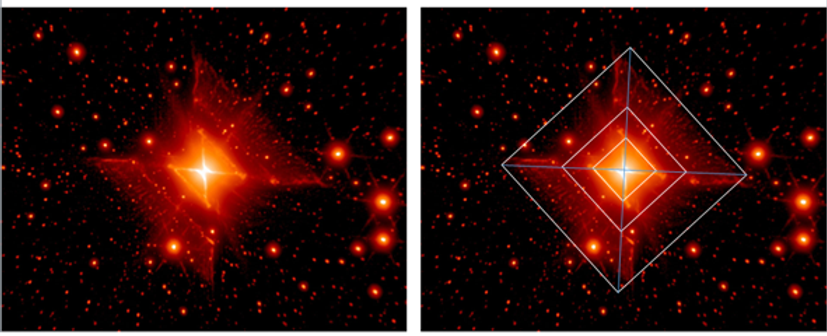Has the Riddle of the Sphinx been solved?
The Turning Point
Theturningpoint: Nature, Science, Philosophy, Symbolism, Geometry... Pyramids of Giza
The Red Square Nebula

Image Credit: Peter Tuthill, Sydney University
The Red Square Nebula was first imaged by Peter Tuthill of the University of Sydney in 2007. This nebula stands alone in the symmetry it presents...
Looking suspiciously like a hypercube in the frame above, this image is perhaps the first time humanity has witnessed a trace of the hypercube form in nature. Given the huge, variable, energy densities found in the nebula, it is The Turning Point's hypothesis that usually hidden features (i.e. spinning Transcendental Pyramid and associated hypercube tessellation of space) of a natural system revealed themselves when the speckle imaging technique* was used in making this image.

Image Credit: Peter Tuthill, Sydney University
A bicone (Bi-Polar) structure of the nebula is suggested by Peter Tuthill et al. Given this structure is correct, then a correlation exists with hypercube form as seen below. The cones fit inside hypercube geometry neatly. (Note that only one hypercube sub domain is shown in the figures below for clarity. Another "half step" domain if rendered would cause another ladder feature to be extant as in the above original images.)



The "comb" feature of The Red Square Nebula as outlined below can be explained by the imaging technique used (speckle imaging) and a spinning Transcendental Pyramid distributing various energy densities.
Comb Feature PowerPoint
Offers hypothesis on comb feature generation. A spinning Transcendental Pyramid while generating the energy density of the nebula "seeds" the same nebula with Transcendental Pyramid edges as a result of the speckle imaging technique. These Transcendental Pyramid edges are captured optically as the combs embedded in the bicone.
Note: Download PowerPoint file and choose Slide Show tab. Then select "From the Beginning Tab" to start program. The file will execute in a few seconds.
Red Square Full Model with Transcendental Pyramid Sweeping Action.
Speculative model of Red Square generation by means of Transcendental Pyramid.
Note: Download PowerPoint file and choose Slide Show tab. Then select "From the Beginning Tab" to start program. The file will execute in a few seconds.
Speckle imaging describes a range of high-resolution astronomical imaging techniques based on the
analysis of large numbers of short exposures that freeze the variation of atmospheric turbulence. They can be divided into the shift-and-add ("image stacking") method and the speckle interferometry methods. These techniques can dramatically increase the resolution of ground-based telescopes, but are limited to bright targets. - Wikipedia
Speckle masking (or bispectral analysis, as applied to speckle imaging), is a method which involves estimation of the bispectrum or closure phases from each of the short exposures. The "average bispectrum" can then be calculated and then inverted to obtain an image. With a normal telescope aperture, a large number of short exposures must be averaged to remove the effects of the atmosphere. If a non-redundant aperture mask is used the bispectrum can be calculated without any noise contribution from the atmosphere (but still with a photon shot noise error contribution). In this arrangement a ground-based telescope aperture is blocked by astronomers apart from a few holes which allow light through, creating a small optical interferometer with the resolving power of a diffraction-limited telescope rather than being limited by the astronomical seeing. - Wikipedia
The Turning Point believes the comb pattern is a result of the stacked short exposure time plates used to make the image. In other words, this technique essentially caught the edges of the Transcendental Pyramid in "freeze frame."


Image Credit: Peter Tuthill, Sydney University
As seen in the above frames, two Transcendental Pyramids rapidly spinning in tandem about two axes, if imaged by stacked images of exceptionally short duration and very high resolution, could result in generating the unusual "comb" features of the Red Square Nebula. This hypothesis would be in keeping with Perennial Philosophy in that two related "poles" of action seed the overall dynamic as described thus far...
The Butterfly Nebula - NGC 6302: Another Possible Bicone Remnant

Image Credit: NASA, ESA, and the Hubble SM4 ERO Team
???

More detailed scheme of rotation about hypercube center: Propose counter rotating, tandem Transcendental Pyramids that at the same time sweep in parallel the surface area of a sphere. In this manner, chirality (left and right handedness) is part of the system. See bottom of "New Science" page for descriptive video and more images of dynamics. New Science | theturningpoint (tturningpoint.com)